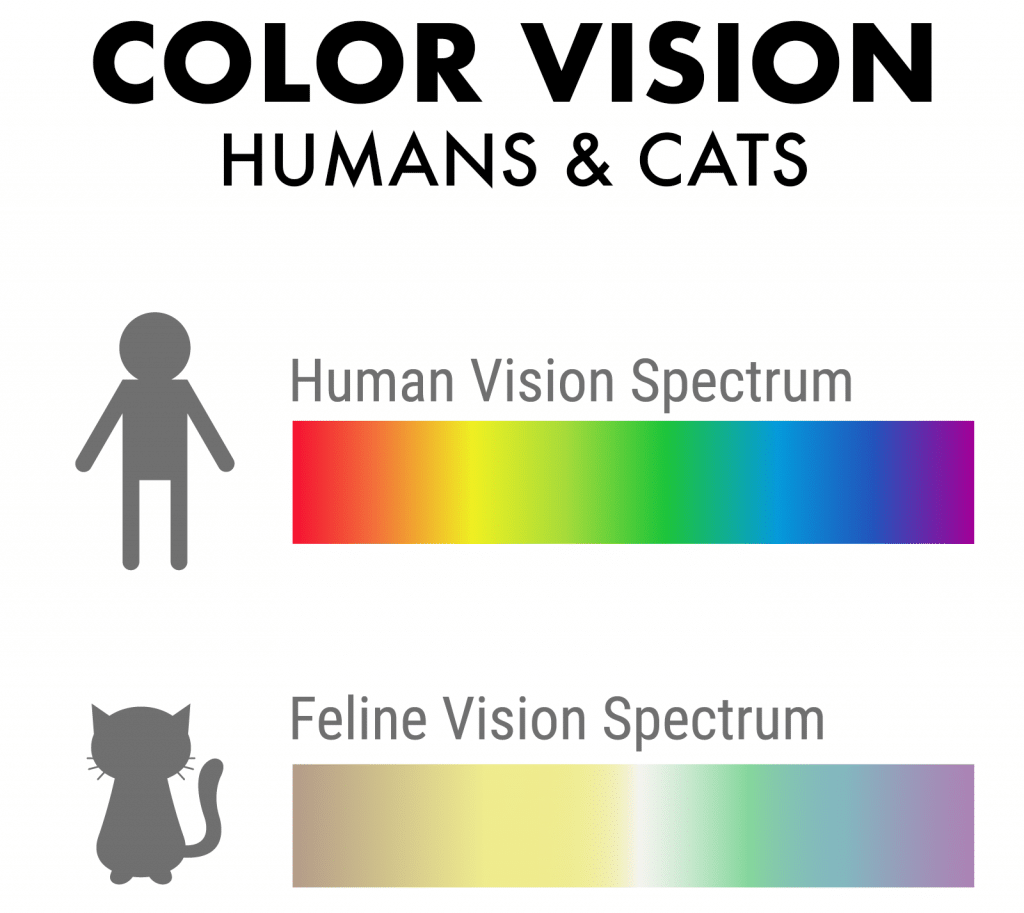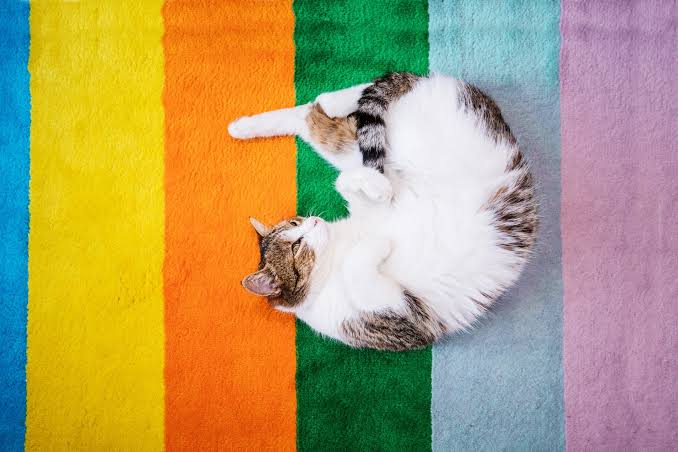Ever wondered what the world looks like through your cat’s eyes? Cats have a unique way of seeing the world, and their color vision is quite different from ours. In this article, we’ll explore the fascinating topic of what colors cats can see and how their vision compares to that of humans.
Unlike humans, who have three types of cones in their eyes for perceiving colors, cats have only two. This means that while cats can see some colors, their range of color vision is more limited than ours. Understanding how cats see colors can help us create environments that are visually stimulating and comfortable for our feline friends.
So, let’s dive into the world of feline vision and discover what colors cats can see and how they perceive the world around them. By the end of this article, you’ll have a better understanding of your cat’s unique perspective and how to cater to their visual needs.
Recommended article: How to Know When a Cat is Pregnant: Symptoms Of Early Pregnancy in Cats
How Cats See Color
Have you ever wondered how cats perceive the colorful world around them? While cats can’t see the full spectrum of colors like humans do, they have a unique way of seeing the world that is perfectly suited to their needs as predators. Let’s take a closer look at how cats’ eyes and retinas differ from humans, leading to their fascinating but limited color perception.
Cats’ Eyes vs. Human Eyes

Cats’ eyes have a different structure compared to human eyes, particularly in the retina, which is the light-sensitive layer at the back of the eye. Unlike humans, who have three types of cones in their retinas to perceive colors (red, green, and blue), cats have two types of cones, which limits their color vision to a range of blues and greens.
The Role of Cones in Color Vision
Cones are photoreceptor cells in the retina responsible for detecting different wavelengths of light, which our brains interpret as colors. Humans have cones that are sensitive to red, green, and blue light, allowing us to see a wide range of colors. Cats, on the other hand, have cones that are sensitive to blue and green light, but not to red light.
How Cats’ Color Vision Works
Cats’ color vision is similar to that of humans with red-green color blindness, also known as deuteranopia. They can distinguish between shades of blue and green, but they have difficulty differentiating between red and green hues.
Adaptations for Hunting
Cats’ limited color vision is actually an adaptation for their hunting behavior. In the wild, they rely more on motion and contrast than on color to detect prey. Their ability to see well in low light and detect subtle movements helps them stalk and capture their prey effectively, making color vision less crucial for their survival.
Comparing Human and Cat Vision
To put it simply, if we imagine the color spectrum as a rainbow, humans can see all the colors of the rainbow, while cats can only see a part of it, mainly the blues and greens. This limited color vision doesn’t diminish the richness of their visual experience; it’s just different from ours and perfectly suited to their needs as nocturnal hunters.
While cats may not see the world in the same vivid colors as humans, their unique vision allows them to thrive in their natural environment. Understanding how cats see color gives us a glimpse into their fascinating sensory world and helps us appreciate their abilities as hunters and companions.
Recommended article: Brown Cat Breeds
Types of Cones in Cats’ Eyes and Their Effect on Color Perception
Cats’ eyes are fascinating organs that have evolved to meet their specific needs as hunters. Here’s a closer look at the types of cones in cats’ eyes and how they affect their ability to perceive colors:
- Blue-sensitive cones: Cats have a higher concentration of blue-sensitive cones in their retinas compared to humans. These cones are most sensitive to short wavelengths of light, which correspond to the blue end of the spectrum.
- Green-sensitive cones: Cats also have green-sensitive cones, but they are less sensitive compared to humans. These cones are responsible for detecting medium wavelengths of light, which include the green part of the spectrum.
Limited Color Perception:
- Due to the absence of red-sensitive cones in their retinas, cats have limited ability to perceive colors in the red spectrum. This means they cannot distinguish between red, orange, and certain shades of brown and green.
- Cats’ color vision is often compared to that of humans with red-green color blindness, known as deuteranopia. They see the world in shades of blue and green, with less differentiation in the red and yellow hues.
Effect on Hunting Behavior:
- Cats’ color vision, while limited compared to humans, is well-suited to their predatory nature. They rely more on motion and contrast than on color to detect prey, making their ability to see in low light and detect subtle movements more crucial for hunting success.
- Their visual acuity and ability to perceive depth and distance are more important for stalking and capturing prey than their color vision.
Adaptations for Nocturnal Hunting:
- Cats are crepuscular hunters, meaning they are most active during dawn and dusk when light conditions are low. Their eyes are adapted to low light conditions, with a high concentration of rod cells in their retinas for improved night vision.
- While their color vision may be limited, cats’ other visual adaptations, such as their large pupils and reflective tapetum lucidum, enhance their ability to see in dim light and hunt effectively at night.
Cats’ color vision is different from humans’, with a focus on blues and greens and limited perception of reds and oranges. This unique vision is a result of their evolutionary adaptations as hunters, allowing them to thrive in various light conditions and excel in their role as nocturnal predators.
Recommended article: Grey and White Cat Breeds
What Colors Can Cats See?

Let’s take a closer look at feline color vision and explore the colors that cats can see.
- Blues and Greens: Cats have good sensitivity to blues and greens due to their abundance of cones that are sensitive to these wavelengths. They can perceive various shades of blue and green, which may appear more vivid to them compared to other colors.
- Yellows and Grays: Cats can also see some shades of yellow, falling within the range of wavelengths that their cones can detect. However, yellow may appear less distinct to cats compared to blues and greens. Cats also have good sensitivity to grays, which they may perceive as different shades of white.
Impact of Color Vision on Cats
- Hunting and Survival: Cats’ color vision is adapted for their natural hunting instincts. Their ability to see blues and greens helps them distinguish prey against green foliage or blue skies, giving them an advantage in hunting and survival.
- Toy Preferences: Cats’ color vision can influence their preferences for certain toys. Toys that are blue or green may appear more appealing to cats, as these colors are more visible and stand out to them.
Cat-Friendly Colors
When choosing colors for cat toys, bedding, or accessories, consider using blues and greens, as these colors are more visible to cats. These colors can help stimulate their senses and make their environment more engaging.
While cats may not see the world in the same vibrant palette as humans, they have their own unique way of perceiving colors. Understanding their color vision can help us create environments that are more enriching and stimulating for our feline friends.
Recommended article: 10 Fruits you Can Give your Cat
Colors Cats Cannot See
Cats have difficulty distinguishing between colors in the red, orange, and brown range. This is because they lack a third type of cone that is sensitive to long wavelengths, which would allow them to perceive these colors. Without this cone, colors such as red, orange, and brown appear as shades of gray to cats. This limited color perception is a result of their evolutionary adaptation to their natural environment, where they rely more on other senses, such as smell and hearing, for survival and hunting.
While cats’ color vision may be limited compared to humans, it is well-suited to their needs as hunters and predators. Their ability to see shades of blue and green helps them detect movement and distinguish objects in low light conditions, which is advantageous for hunting prey. Despite their limited color vision, cats have other visual abilities that compensate for this limitation, making them efficient hunters and well-adapted to their natural environment.
Recommended article: The Best Wet Cat Food Dispenser of 2024
What Cats See When They Look at Humans
While cats may not see human facial expressions with the same clarity as we do, they are adept at reading body language and subtle cues. They can pick up on changes in our posture, tone of voice, and overall demeanor to gauge our emotions and intentions. Cats are known to respond to their owners’ emotional states, such as offering comfort when they sense distress or seeking affection when they sense happiness.
Cats’ eye contact with humans is a form of communication. When a cat makes eye contact with you, it can be a sign of trust, curiosity, or even a request for attention. Some cats may avoid prolonged eye contact, as it can be perceived as a threat or challenge in feline social interactions. Understanding your cat’s body language and comfort level is key to interpreting their behavior.
Despite their different visual perception, cats form strong bonds with their human companions. They fo this based on trust, familiarity, and positive experiences. Cats rely on other senses, such as smell, touch, and hearing, to navigate their relationships with humans. They may rub against you to mark you with their scent or purr to show contentment and affection.
When cats look at humans, they see a world that is different from ours in terms of clarity and color. However, their ability to interpret our body language and emotions allows them to form deep connections with us. Understanding and respecting their unique visual abilities can enhance the bond between cats and their human companions.
Recommended article: 30 Valentine’s Day Gift Ideas for Pets
Frequently Asked Questions About What Colors Cats Can See
Can cats see in color?
Yes, cats can see in color, but their color vision is different from humans. They have fewer color-sensitive cones in their eyes compared to humans, which means they see a more limited range of colors. Cats’ vision is skewed towards blues and greens, and they have difficulty distinguishing between reds and oranges.
What colors are most visible to cats?
Cats can see blues and greens more vividly than others. Reds and oranges appear more muted or desaturated to cats due to their limited ability to perceive these colors.
Do cats see in black and white?
Contrary to popular belief, cats do not see in black and white. They have a limited color vision that includes shades of blues and greens. While their color perception is not as rich as humans’, they can still distinguish between different colors to some extent.
Do cats see the world differently at night?
Yes, cats’ eyes are adapted for hunting in low light conditions. They have a higher number of rod cells in their retinas, which enhances their ability to see in dim light. This adaptation allows them to navigate and hunt effectively in low light environments.
How does a cat’s vision compare to human vision?
Cats’ vision differs from humans’ in several ways. They have better night vision and motion detection but poorer visual acuity and color perception. While humans have three types of color-sensitive cones in their eyes (red, green, and blue), cats have only two types (blue and green), which limits their ability to see the full spectrum of colors.
Recommended article: Essential Tips For Traveling with your Pet
Conclusion
Understanding what colors cats can see offers fascinating insights into the unique visual world of our feline companions. While cats’ color vision is different from ours, they are still able to navigate their environment and form deep bonds with humans based on other sensory cues. By appreciating their visual abilities and respecting their unique perspective, we can enhance our interactions with cats and provide them with a fulfilling and enriching environment.
For more articles on pet-related topics such as grooming tips, behavior insights, safety guidelines, breeding advice, and more, check out our website. Stay informed and connected to the world of pet care and companionship!

